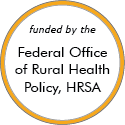Rural Project Examples: Networking and collaboration
Effective Examples
Medical Legal Partnership of Southern Illinois
Updated/reviewed November 2024
- Need: Legal barriers often prevent low-income people in Southern Illinois from obtaining positive health outcomes despite receiving medical care.
- Intervention: The Medical Legal Partnership of Southern Illinois (MLPSI) was formed to create a system where medical providers can refer patients in need of legal assistance to local attorneys.
- Results: Over 5,700 patients have utilized MLPSI since its founding in 2002. The program has relieved over $8.1 million in medical debt for both hospitals and patients.
Promising Examples
Arkansas Rural Health Partnership Hospital-based Transitional Care Program

Added July 2024
- Need: Solutions for Medicare beneficiaries' post-acute care recovery gaps in Arkansas's southeast Delta Region.
- Intervention: Supported by federal funding and their membership organization, seven hospitals implemented an evidence-supported Critical Access Hospital transitional care model.
- Results: Participating hospitals found a significant increase in swing bed services revenue, an all-cause low readmission rate, high percentage of patients discharged to home or to an assisted living environment, and positive patient satisfaction surveys.
Maryland Faith Health Network
Updated/reviewed December 2022
- Need: To coordinate formal and informal community-based caregivers for optimal patient experience.
- Intervention: The Maryland Faith Health Network unites places of worship and healthcare systems in Maryland. This program aims to decrease the amount of potentially avoidable hospitalizations, improve a patient's overall wellness, and cut down on the cost of medical services.
- Results: This model is currently running in 3 hospitals that serve both rural and urban residents in central Maryland. So far, 1,300 congregants from 70 congregations representing Christian, Jewish, and Muslim faiths have enrolled in the Network.
Other Project Examples
Healthy Adams County
Updated/reviewed November 2025
- Need: To create initiatives in rural Pennsylvania communities to address locally-identified health disparities.
- Intervention: Healthy Adams County was created by Adams County residents to promote community-wide health.
- Results: Community task forces have been formed to address healthcare access, female cancers, food policies, behavioral health, children's health & nutrition, domestic violence/sexual assault, and other community-identified needs.
Healthy Monadnock Alliance
Updated/reviewed November 2025
- Need: Improved health outcomes for Monadnock Region, a rural area of New Hampshire.
- Intervention: A wide-scale effort across multiple sectors is aiming to improve health outcomes throughout the region.
- Results: Community health trends have been tracked over time, and progress on goals such as increasing the number of residents with healthcare coverage, opportunities for physical activity, access to healthy foods, and smoking cessation has been made.
Wisconsin Collaborative for Rural Graduate Medical Education
Updated/reviewed November 2025
- Need: Primary care physicians in the rural areas of Wisconsin.
- Intervention: A GME collaborative and technical assistance center that provides leadership, GME expertise, and support for expanding rural graduate medical education in Wisconsin.
- Results: The collaborative expanded rural graduate medical education opportunities which now include over 30 rural-focused residency programs. There are several GME opportunities in specialties ranging from family medicine to surgery, obstetrics/gynecology, psychiatry, internal medicine and more.
HCC Network's Project Connect Event
Updated/reviewed October 2025
- Need: To expand public health and human services to adults living in rural West Central Missouri.
- Intervention: HCC Network organized Project Connect events, daylong resource fairs that offer free public health and human services to low-income adults, and now serves as a resource for other organizations who would like to host a Project Connect event in their area.
- Results: In 2024, local Project Connect events welcomed 100 families and offered numerous services and resource connections.
HopeWest
Updated/reviewed September 2025
- Need: To provide accessible and affordable services to address the challenges associated with aging, serious illness, and grief across rural western Colorado.
- Intervention: A nonprofit, community-sustained healthcare model was created to provide the Program of All-Inclusive Care for the Elderly (PACE), dementia support, hospice care and palliative care, as well as grief support services for individuals of all ages.
- Results: Since 1993, HopeWest has grown to serve more than 3,000 patients and families annually across five counties in western Colorado.
Columbia Gorge Collective Impact Health Specialist
Updated/reviewed July 2025
- Need: To address the specific health needs of north-central Oregon and south-central Washington.
- Intervention: The Collective Impact Health Specialist identifies community needs, convenes community partners to design initiatives that address those needs, and secures funding for health-related initiatives.
- Results: Thanks to the CIHS, the Columbia Gorge region has received $35.4 million since 2014.
Montana Interfacility Blood Network (MT IBN)
Updated/reviewed July 2025
- Need: To provide blood transfusions in the ambulance on the way to a hospital.
- Intervention: The Montana Interfacility Blood Network includes 48 healthcare facilities that stock blood and allow ambulances to pick up units of blood while transporting a patient.
- Results: Since its launch, the network has helped at least three patients.
For examples from other sources, see:
